Anti-spin and long pimples, yuk! They should be banned! Everyone should have to use normal rubbers!
Sound familiar? I think we all have heard a fellow table tennis player say this at one time or another. I’m not going to get into why I think they should be allowed and even encouraged, that’s a topic for another article. Suffice to say that anti-spin and long pimples don’t look like disappearing soon, and although there may not be many players in the World’s Top 100 Men using anti-spin or long pimples, I’m willing to bet that you, dear reader, are not in such elite company either or else you probably wouldn’t be interested in hearing my views on how to play against these ‘funny’ or ‘junk’ rubbers. I’ve covered anti-spin in an another article, now it’s the long pimpled rubbers turn.
(Note: This guide is more to do with the theory behind how long pimples work. I’ll be giving specific tips on how to play against different types of long pimple users in separate articles.)
So take a deep breath, gird up your loins and read on…
What is Long Pimpled Rubber?
The name “long pimples” pretty much gives it away. Long pimpled rubber is a table tennis rubber that has pimples, or pips, coming out from the surface of the rubber. This pimples are much longer than the traditional short pimples that are popular for flat-hitting attackers. The actual length of the pimples can vary from manufacturer to manufacturer, so what one person calls long pimples another may call only medium pimples. The overall effect of medium pimples is the same as long pimples but just less pronounced, so you can extend this guide to medium pimpled rubbers as well. Sponge rubber may or may not be used underneath the topsheet.
Why do People use Long Pimpled Rubber?
Long pimples is used by players of a variety of styles, but overall there are three main reasons why long-pimples is used:
- To provide good control of the ball regardless of what shot your opponent makes;
- To provide variation in the behavior of the ball in comparison to strokes made with the normal rubber that is typically on the other side of the bat;
- To allow the user of long pimples to turn or ‘twiddle’ the bat in his hand and make his opponent incorrectly guess which side of the bat was used, thus forcing a poor return.
How Do Long Pips Work in Theory?
As we discussed with antispin rubbers, there are several factors involved in how a particular long pimpled rubber works. Each long-pimpled rubber uses these factors differently, which is why no two long-pimpled rubbers play exactly the same way. The factors involved are listed below. Please keep in mind that this is my theory about long pimples, so I’m not claiming to be the last word on the subject.
Please keep in mind that in the items discussed below, the amount of spin we are talking about is much less than for inverted rubbers, but it is still significant.
(1) Amount of Grip of the Top of the Pimples.
All long pimpled rubbers have much less grip than normal rubbers, but this does not mean that they all have no grip. There is actually quite a difference in grips between different long-pimpled rubbers. The more grip they have, the more the player will be able to change the spin that you have put on the ball. Some long pimples have smooth, almost glassy pimple tops that do not grip the ball at all, while others have rougher pimple tops that will grip more, and yet others have a smooth pimple top that grips.
(2) Amount of Grip of the Sides of the Pimples
The sides of the pimples can vary in the same way as the tops, with similar effects. Bear in mind that the sides do not have to be the same as the tops! The importance of this fact will be clearer after reading the next point below.
(3) Softness of the Pimples
The softer the pimples, the more they will tend to bend when the ball is hit, and the more the sides of the pimples will be able to touch and affect the ball. Stiff pimples will require more force before they bend, but once they do, they may bend quite a lot! A player using softer pimples will be able to produce more spin variation that a player using stiff pimples, provided that the sides of the pimples have some grip.
(4) Width, Density, and Shape of the Pimples
The wider the pimples, the less they will tend to bend, and thus the less the sides of the pimples will touch the ball. The more dense the pimples, the more contact can be made with the ball and the more the rubber will be able to affect the spin. The shape of the pimples is a bit more difficult to figure out. Most pimples are the same width at the bottom and the top, but not all. The pimples that I used to use were actually narrow at the bottom and wide at the top, like a funnel or ice cream cone. I believe that this tends to make the tops of the pimples get more contact with the ball while the sides of the pimples get less. Whether this is true, and whether it is even a significant difference is open to debate (I liked them though!). I assume the reverse would be true for a long pimpled rubber with a wide base and narrow top.
(5) Thickness and Hardness of the Sponge
The thicker and softer the sponge, the more the pimples will sink into the sponge when the ball is hit, and the more pimples will be able to touch the ball to generate spin. The sponge will also help catapult the ball back from the bat, adding some speed to the ball. Long pimpled rubbers without sponge will tend not to have this catapult effect, and will be slower than their sponge counterparts.
(6) Speed of the Rubber
The faster the overall rubber, the less time the ball will stay on the rubber and the less opportunity to spin the ball. I think that there have been studies done that indicate that the speed of the rubber does not affect the dwell time, but this is my gut feel about the effect of rubber speed.
(7) Speed Glue
Speed glue softens the sponge, allowing the pimples to sink into the sponge and allowing more pimples to touch the ball, as in (5) above. It also increases the catapult effect, increasing the speed of the return.
(8) The Type of Stroke Used
The type of stroke used is very important with long pimpled rubber, much more so than for anti-spin rubbers. I don’t think I can do this factor justice in a short paragraph, so I’ll deal with it later in the article on a page of its own.
(9) Speed and Bounce of the Return
The effect of the long pimples on the spin of the ball is not the only problem that you will face. Compared to a stroke with an ordinary rubber, the amount of speed on the ball will be less with the same stroke made by an long pimpled rubber. A thicker, harder sponge will tend to return the ball faster, but it will still not be anywhere near as fast as a normal rubber. A speed-glued long pimpled rubber might just about get there, though. In addition, the bounce of the ball off the table will also be different, due to the difference in spin and speed applied by the long pimpled rubber.
All of these factors will affect the amount that your opponent can change your spin. Bear in mind that if you spin the ball and your opponent does not change your spin, the ball will keep spinning in the same way but it’s overall motion will be in the other direction, so if you hit a topspin it will come back to you as backspin, and if you hit a backspin it will come back to you as topspin. This is true regardless of what rubber your opponent is using, it is just easier to do with long pimples. (Think of a chopper chopping a loop, for example. The spin on the ball is always in the same direction, but it is coming to the chopper as topspin, and to the looper as backspin.)
How Do Long Pimples Work in Practice?
To explain how long pimples work in reality, it is probably easiest to compare them to how normal rubber works. Imagine this scenario:
You and your opponent are both using normal rubbers such as Sriver. You topspin loop the ball to your opponent, and he plays his stroke by moving his bat from near his knee to above his head, in a fairly typical topspin action. What type of speed and spin will be on the ball that is coming towards you?
Answer: The type of spin can vary all the way from a slow heavy topspin if your opponent has spun the ball without much forward motion, to a medium-fast loop with medium spin if he has spun the ball and hit through the ball about equally, to a very fast loop or drive with not very much spin if he has hit through the ball without spinning it much.
In this day and age of smooth grippy rubbers, most intermediate and advanced players will know what is happening instinctively when they are playing, and adjust accordingly. This type of topspin rally is what the many hours of training has prepared you for. It is an entirely predictable scenario – if you watch your opponent’s stroke closely enough, you will know what spin and speed is on the ball coming towards you.
Now imagine that your opponent is playing with a long pimpled rubber. Once again, you topspin loop the ball to his forehand, and he uses the long pimpled side to play a stroke from his knee to his head, in a fairly typical topspin action. What type of speed and spin will be on the ball that is coming towards you?
Answer: The ball will be anywhere from a heavy backspin ball to a float ball, depending on the type of long pimples used and the type of contact made by your opponent. It will not be a topspin ball. Read on for the reasons why.
What Happens When You Topspin?
The Short Version
As Carl Danner was nice enough to point out in my article on anti-spin rubbers, the short version for both topspin and backspin with anti-spin is as follows – “Basically, anti-spin continues the spin already on the ball, so you get (effectively) back the opposite of what you have hit — only slightly less intense, as you noted.” This still holds true for long pimples, but with a couple of important points to be aware of.
Long Pimples vs Anti-spin – What’s the Difference?
“Anti-spin, long pimples, whatever! They’re both funny rubbers – how different can they be?” Very different, young Jedi. Now pay attention and I’ll explain why you can’t always treat anti-spin and long pimples in exactly the same way. Note that the stiffer the pimples, and the less friction on the pimple tops and sides, the more the long-pimples will tend to act like anti-spin. But as the grip of the pimple tops and sides increases, and the more the pimples tend to bend, the more important the two factors mentioned below become.
Reason 1: Long Pimples CAN kill the spin on the ball.
| OK, so the purists will argue that this is not exactly true. But take it from me, an experienced long pimples player can take your spinny loop drive and float it back with very little spin, or at the very least much less spin than you think will be on the ball. How does this work? Imagine the table tennis ball that you have looped going spinning into the long pimples of your opponent. (See Figure 1) If he meets the ball with a relatively flat stroke, the pimples on his bat will tend to bend in all sorts of directions, and then spring back. (See Figure 2) If the tops and sides of the pimples are grippy enough, and if the pimples are flexible enough, they can greatly reduce the amount of spin on the ball, as all the pimple tops and sides will grip the ball and attempt to give it different spins, which will tend to cancel each other out, as well as helping to reduce the original spin on the ball. (See Figure 3)
Many players don’t think that this is really possible. But keep in mind that with normal rubber, part of the reason you can spin the ball is because there is plenty of grippy contact between the table tennis ball and the topsheet of the rubber. So if the long pimples have grippy pimple tops and pimple sides, then when the pimples bend there can actually be a lot of rubber contacting the ball. Borrow a friend’s pimpled rubber sometime and press the ball into the surface, and watch how the pimples bend and how the amount of contact with the ball dramatically increases. |
Figure 1 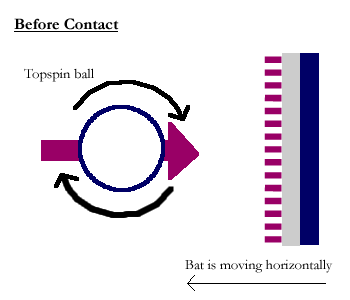 |
Figure 2 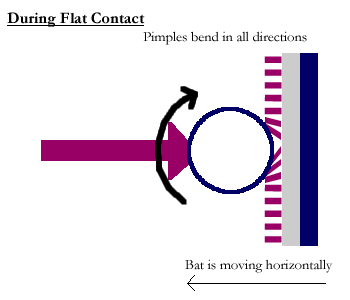 |
|
Figure 3 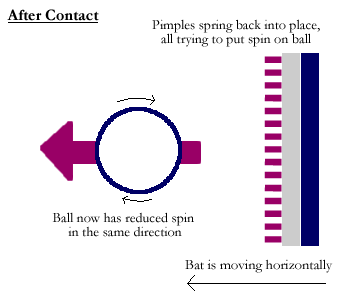 |
Reason 2: Long Pimples can dramatically INCREASE the spin on the ball.
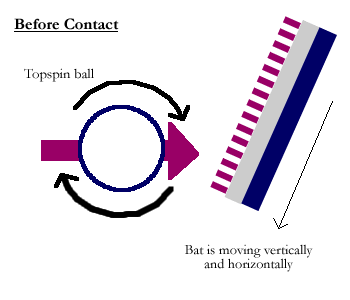 Figure 1 Figure 1 |
“What? You just said that the pimples can kill the spin on the ball! How can they increase the spin as well? It doesn’t make sense!” Rest assured, dear reader, it does make sense and it can happen. Here’s why:
Imagine, once again, that you have looped the ball to your opponent. Your opponent hits the ball with his long pimples, and at the moment of contact, he brushes the ball in the same direction as the spin (ie the ball is spinning forward down towards the floor, and the opponent is also hitting from high to low, down towards the floor). So the pimples are now going in the same direction as the spin on the ball. (I’ll try to add a suitable picture for this explanation later, for the moment your imagination will have to do)(Note: Pictures added. GL 2nd March 2005). If the pimple tops and sides are grippy enough, and the pimples are flexible enough, they will have a lot of contact with the ball and thus will be able to add to the spin on the ball, making your opponent’s reply a very heavy backspin ball. |
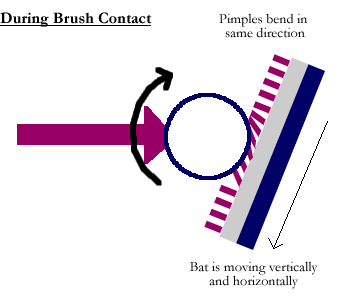 Figure 2 Figure 2 |
|
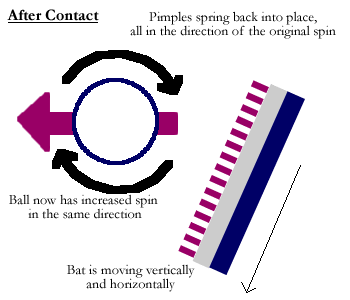 Figure 3 Figure 3 |
These are the main two reasons long pimples cannot be treated in the same manner as anti-spin. Ignore them at your peril.
What happens when I topspin? – The Long Version
The examples shown below are assuming that your opponent is using a long pimpled rubber with medium speed, and reasonably flexible pimples that have some grip. As the pimples get stiffer and their grip becomes less, the more they will play like anti-spin, which I have already explained. The grippier and more flexible the pimples are, the more pronounced their effects mentioned below will be. Again, this will vary for each type of long pimples, as they all have slightly different characteristics.
(A) Your topspin to your opponent’s topspin style stroke.
- You hit a heavy topspin ball. Your opponent hits the ball with a topspin style stroke and with flat, non-brushing contact. The long pimples will bend in many directions and grip the ball, thus tending to kill the spin as they all spring back into position. The ball will come back to you fairly quickly and with float or a little backspin. Why you will hit a bad stroke next – with a conventional rubber his return would have no spin or a little topspin. Your bat angle will be incorrect, and the ball will go into the net.
- You hit a heavy topspin ball. Your opponent hits the ball with a topspin style stroke and brushes the ball rather than flat hitting it. The pimples will tend to bend in the opposite direction to the way your opponent’s bat is moving, which means that as they spring back they will work to decrease the amount of spin on the ball. The ball should come back to you as a light backspin to a very light topspin, depending on the amount of grip and bend of the pimples. Why you will hit a bad stroke next – with a conventional rubber his return would have medium to heavy topspin. Your bat angle will be incorrect, and the ball will bounce on your side of the table.
(B) Your topspin to your opponent’s chop style stroke
- You hit a heavy topspin stroke. Your opponent hits the ball with a backspin style stroke and with flat, non-brushing contact. The long pimples will tend to bend in all directions, gripping the ball in a pincer-like effect, before rebounding to their original positions. This will tend to kill the spin on the ball, so the ball should come back to you fairly quickly and with little or no backspin. Why you will hit a bad stroke next – with a conventional rubber his return would have little or no backspin. So in theory, you actually should hit a good shot. We’ll come back to this point later.
- You hit a heavy topspin ball. Your opponent hits the ball with a backspin style stroke and brushes the ball rather than flat hitting it. Now the pimples will tend to bend in the same direction (the opposite to the direction the bat is moving), so when they spring back they will increase the spin on the ball. The ball should come back with a very heavy backspin. Why you will hit a bad stroke next – with a conventional rubber his return will have medium backspin. Your bat angle will be incorrect, and the ball will go into the net.
Advanced Tactics
You probably noticed that in B1 above, you were actually lucky enough to pick the right spin, even though your reasons may have been incorrect. This leads into a discussion of some of the advanced tactics used by combination bat players. As you improve, you will learn how the anti-spin or long pimpled rubbers behave. However, the quality of your opposition is likely to improve as well, and this means that their tactics will change too. At the advanced level, players can figure out very quickly how a particular anti-spin or long pimpled rubber behaves, and will not lose points by misjudging the spin from the funny rubber or by not noticing which side of the bat has been used to strike the ball. So the combination bat player will try to hide the type of contact from his opponent, so the opponent does not know whether the ball has been brushed or hit with solid contact. I’ll go into this topic in more detail when I write about how to use anti-spin and long pimples, but for now, here are a couple of sample scenarios:
1. Imagine that you are an advanced player who knows how long pimples work. You loop the ball, and your opponent returns it using his long pimples. You think he has brushed the ball, but in fact he has made solid contact. Since you know how long pimples work, you think he has increased the spin, but in fact he has reduced it. Your next shot is likely to fly over the end of the table.
2. Again, imagine that you are an advanced player who knows how long pimples work. You loop the ball, and your opponent returns it using his long pimples. You think he has hit the ball solidly, but in fact he has brushed it. Since you know how long pimples work, you think he has reduced the spin, but in fact he has increased it. Your next shot is likely to hit the bottom of the net.
Ok, so much for returns from your topspin strokes. But what happens when you backspin the ball to your opponent?
What Happens When You Backspin the Ball?
The examples shown below are assuming that your opponent is using a long pimpled rubber with medium speed, and reasonably flexible pimples that have some grip. As the pimples get stiffer and their grip becomes less, the more they will play like anti-spin, which I have already explained. The grippier and more flexible the pimples are, the more pronounced their effects mentioned below will be. Again, this will vary for each type of long pimples, as they all have slightly different characteristics.
Here are a few example scenarios and an explanation of what will happen:
(A) Your Backspin to His Topspin Style Stroke
- You hit a heavy backspin ball. Your opponent hits the ball with a topspin style stroke and brushes the ball rather than flat hitting it. Now the pimples will tend to bend in the same direction (the opposite to the direction the bat is moving), so when they spring back they will increase the spin on the ball. The ball should come back with a heavy topspin. Why you will hit a bad stroke next – with a conventional rubber his return will have heavy topspin. So in theory, you actually should hit a good shot. But remember the advanced deception we talked about previously.
- You hit a heavy backspin ball. Your opponent hits the ball with a flat, non-brushing contact. The long pimples will tend to bend in all directions, gripping the ball in a pincer-like effect, before rebounding to their original positions. This will tend to kill the spin on the ball, so the ball should come back to you fairly quickly and with little or no topspin. Why you will hit a bad stroke next – with a conventional rubber his return will have heavy topspin. Your bat angle will be incorrect, and the ball will go into the net.
(B) Your Backspin to His Chop Style Stroke
- You hit a heavy backspin stroke. Your opponent hits the ball with a backspin style stroke and with flat, non-brushing contact. The long pimples will bend in many directions and grip the ball, thus tending to kill the spin as they all spring back into position. The ball will come back to you fairly quickly and with float or a little topspin. Why you will hit a bad stroke next – with a conventional rubber his return will have float or a little backspin. Your bat angle will be incorrect, and the ball will be likely to go into the net.
- You hit a heavy backspin stroke. Your opponent hits the ball with a backspin style stroke and brushes the ball rather than flat hitting it. Now the pimples will tend to bend in the same direction (the opposite to the direction the bat is moving), so when they spring back they will reduce the spin on the ball. The ball will come back to your with a little backspin. Why you will hit a bad stroke next – with a conventional rubber his return will have medium to heavy backspin. Your bat angle will be incorrect, and the ball will ‘pop up’ into the air.
Conclusion
If you are still with me after all that heavy going, congratulations! Now go back and read it again to make sure it all makes sense. Then go out and find a long pimples player and try it out.
In a nutshell, there are 4 basic rules that you must remember:
1. What Did You Just Do to the Ball?
It is important to keep track of what the last stroke you played was – chop or topspin? If you chopped the ball, your opponent will only be able to use his long pimples to give you a return that ranges from float to heavy topspin. Similarly, if you loop the ball, your opponent can only use the long pimples to give you a return that varies from float to heavy backspin. Remember, the range of possible returns is wider with long pimples than for anti-spin.
2. What Stroke Did Your Opponent Play?
If he plays the opposite stroke to you (ie chop against topspin), he will be able to float the ball or put heavy spin on the ball by accentuating your original spin. If he plays the same stroke as you, the ball is likely to be lightly spun but the opposite type (ie his topspin stroke from your topspin will give slight backspin), or a float ball.
3. What Side of the Bat Did He Use?
Remember, all of the above assumes that your opponent actually hit the ball with the long pimpled side. All bets are off if your opponent twiddles the bat and uses the conventional side when you are not looking!
4. What Type of Contact did He Make?
This is more important for long pimples than for anti-spin, which has much less ability to change the spin on the ball. Remember, the advanced long pimples player will assume that you know how to adjust to his long pimples, and he will be trying to both vary and hide the type of contact he makes, in the hope that you will play the right type of shot to the wrong type of ball.
When in Doubt, What Do I Do?
Sooner or later, it’s going to happen. Your long pimples using opponent hits the ball and you don’t remember what spin you put on the ball, or you didn’t notice what side your opponent used. Or even worse, you don’t know what type of contact he made with the ball. What is your best course of action? The way I see it, you still have the same two choices that you had against anti-spin rubber:
- My own personal recommendation is to hit the ball slowly but put as heavy a spin on the ball as possible, based on the theory that if you heavily spin the ball you will have a better chance of overriding whatever spin is on the ball already, and the slowness of the shot will give you a large area of table to land the ball on.
- Other players I know like to hit the ball as fast and flat as they can, working on the principle that if you pick a specific spot on the table and aim for it, hitting quickly and flat should help kill the spin on the ball and it will hopefully go in a straight line towards where you have aimed.
Which theory works best for you? – try it out and see!

